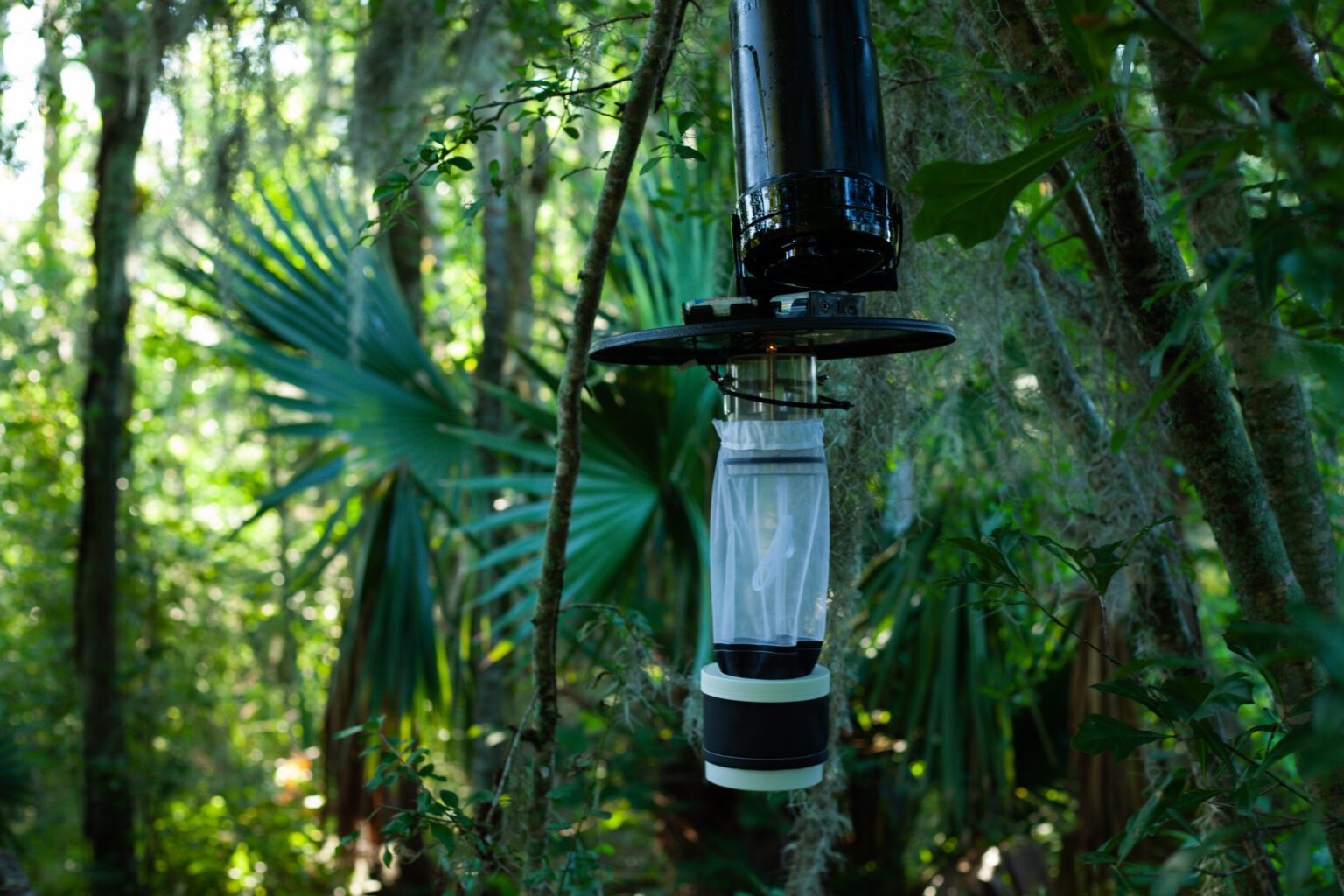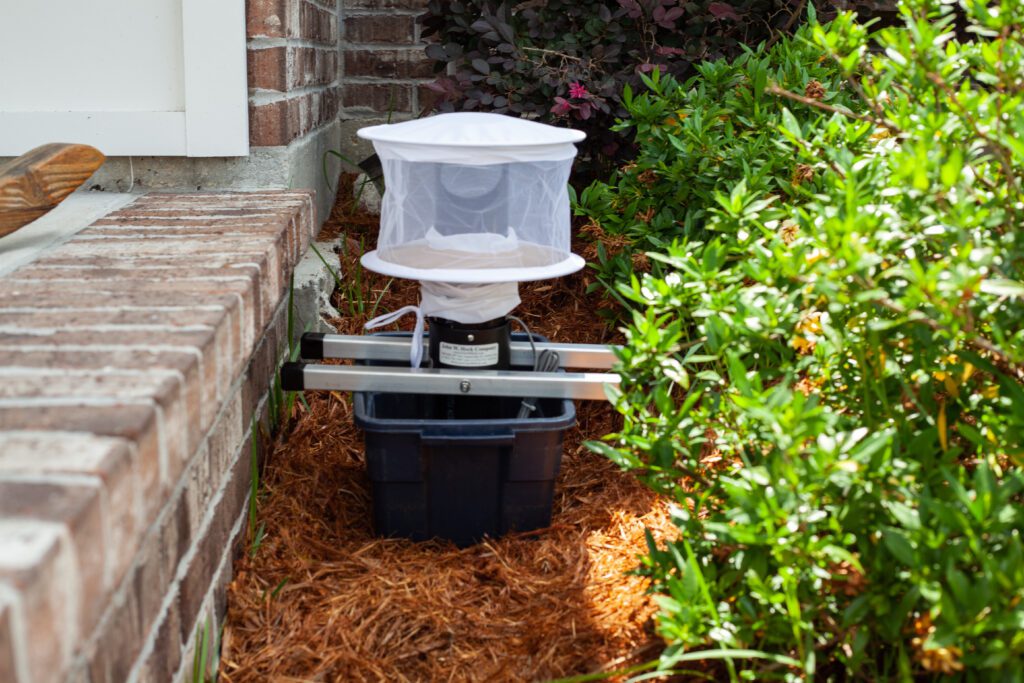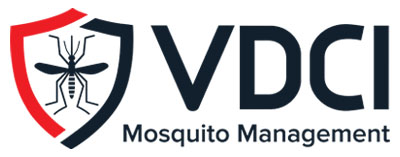How Professional Mosquito Trapping Works
Mosquitoes are more than just pesky insects that cause itchy bites in the summer months – they can also transmit harmful diseases, making them a threat to public health. Professional mosquito trapping is utilized by experts to gain a better understanding of the local adult mosquito population and determine if a potential disease threat exists. Professional mosquito traps serve as important tools to determine the mosquito life stage, species, and population size in a particular area. Once adult and immature mosquitoes are collected, they are sorted, counted, analyzed, and tested for disease so we can gather vital data that can help form more effective Integrated Mosquito Management (IMM) programs to better protect our communities from mosquito-borne diseases.

What is Mosquito Trapping?
Our entomologists employ mosquito surveillance to better understand the local mosquito populations in a given area. Adult mosquito surveillance typically includes weekly trapping of adult mosquitoes in a given area. The goal of mosquito trapping is to create a baseline of the current mosquito population, identify any population shift, understand the mosquito species distribution in an area, and monitor the threat of mosquito-borne diseases. There are various professional mosquito traps available, and each one is designed to target specific mosquito species. Determining which one to use depends on the information desired. Once the mosquitoes are captured, they are brought back to the lab for counting, species identification, and disease testing. Ongoing professional mosquito trapping helps us know when and where we need to spray to keep populations under control and when there is a risk of mosquito-borne diseases.
Selecting The Right Type of Mosquito Traps
Selecting the right type of mosquito trap is an important aspect of mosquito surveillance. There are various types of mosquito traps. Some are designed to capture specific mosquito species or individuals during a certain life stage (host-seeking versus gravid), while others can capture a wide range of species. By using the appropriate professional mosquito trap, our entomologists can collect accurate data on local mosquito populations and determine if there is a risk of mosquito-borne diseases.

CDC Trap
CDC traps are widely used in adult mosquito surveillance. These mosquito traps are portable and run on a 6V battery with a motorized fan to collect mosquitoes. The most common model comes with a small adjustable light and may be supplemented with dry ice, which releases carbon dioxide (CO2), thereby acting as a mosquito bait source to mimic the exhaled respiratory gases of birds or mammals. Once drawn in, the mosquitoes are forced downward by the fan into the collection net, where they cannot escape. CDC traps are typically deployed at dusk and collected after dawn to gather data when most mosquito species are active.

BG-Sentinel Trap
The BG-Sentinel trap is a specially designed mosquito trap that targets two particular mosquito species: Aedes albopictus and Aedes aegypti, which are known for transmitting viruses like dengue, chikungunya, Zika, and yellow fever. These mosquito species are common in urban environments and breed in natural and artificial containers. The BG-Sentinel trap is made up of a tarp-like material and is about the size of a five-gallon bucket. It uses an attractant such as Octenol lure, human scent lure, or CO2 to lure mosquitoes towards the trap. Once the mosquitoes are in the vicinity, a funnel located at the top of the professional mosquito trap directs them toward an electric fan (outlet or battery-powered) that pulls them into a collection net.

Gravid Trap
Gravid traps are specifically designed to capture gravid (egg-laying) Culex mosquitoes, including Culex tarsalis and Culex pipiens, which are capable of transmitting diseases like West Nile virus, St. Louis Encephalitis, and both Western and Eastern Equine Encephalitis. Many Culex species are attracted to water containing high organic material to lay their eggs. Gravid traps utilize a black bucket containing an organic infusion, like grass or hay, that has been left to ferment for several days to mimic stagnant water. Once inside the bucket, a battery-powered fan pulls the mosquito into a collection net. To prevent the trap from becoming a breeding site, it’s important to drain the water attractant from the trap on days when no mosquito trapping is taking place, especially if the trap is located near residential areas.

New Jersey Light Trap
The New Jersey light trap is a versatile mosquito trap that can capture large quantities of mosquitoes and a wide range of species, making it an excellent tool for mosquito surveillance programs. The variety of mosquito species caught can help determine the relative mosquito populations in an area, identify local mosquito vectors, and assist technicians in finding breeding sources. It is best used as a permanent trap and should be securely mounted about five to six feet above the ground and powered by an outlet. The New Jersey Light Trap utilizes a bright light and pulls mosquitoes into the trap via a fan. Dry ice can also be used as an attractant by suspending it above the mosquito trap in a vented container. The attractants in this professional mosquito trap tend to attract
Traps that Aren't Effective for Mosquito Surveillance
It’s important to note that professional mosquito trapping is part of a mosquito surveillance program designed to gather data on the local mosquito population. Professional mosquito traps are not the same as bug zappers or sticky mosquito traps that homeowners may use to control mosquitoes on their property. Bug zappers and sticky traps are not effective for mosquito surveillance. These traps attract a variety of other insects, which can make it difficult for professionals to form an accurate population count. Moreover, few mosquitoes are attracted to these traps, and those that are often have significant damage to their bodies, making them ineffective for mosquito surveillance purposes.
Mosquito Trapping Step-By-Step
Trapping plays a crucial role in our mosquito surveillance programs, helping us better understand the activity of the local mosquito population and develop action thresholds to determine the right time to deploy control strategies. Here’s a step-by-step breakdown of how VDCI conducts mosquito trapping:
- Our team determines the best locations to set mosquito traps to cast a wide net for mosquito surveillance.
- Based on the environment or targeted mosquitoes, we employ the type of mosquito trap needed for surveillance. Mosquito trapping is often conducted weekly over several months to ensure we get an accurate representation of the mosquito population and to understand the mosquito seasonality changes for the particular region.
- Once the mosquitoes are captured, they are taken back to the lab for counting and species identification or to undergo insecticide resistance testing or disease testing.
- Based on the results from these tests, our entomologists will recommend control strategies to decision-makers to ensure mosquito populations do not reach dangerous or nuisance levels.
By employing mosquito trapping as part of an IMM plan, we can provide community leaders and government entities the information they need to protect their citizens from mosquito-borne diseases and help them enjoy the outdoors.

Why Professional Mosquito Trapping Matters
Mosquito trapping is an essential part of any successful IMM program. Comprehensive mosquito surveillance helps monitor population levels, identify mosquito species in an area, and identify potential disease risks.
Professional mosquito trapping data can also be used to determine if the population levels exceed the average number in the area or if there is a mosquito-borne disease present, and control strategies need to be deployed. This ensures our control strategies are as effective and environmentally responsible as possible. The role trapping plays in mosquito surveillance programs is crucial to our IMM programs – helping us to protect public health and keep our communities safe.
Contact Our Experts
Complete the form below to speak to an expert about your community’s mosquito management needs.
 Since 1992, Vector Disease Control International (VDCI) has taken pride in providing municipalities, mosquito abatement districts, industrial sites, planned communities, homeowners associations, and golf courses with the tools they need to run effective mosquito control programs. We are determined to protect the public health of the communities in which we operate. Our mosquito control professionals have over 100 years of combined experience in the field of public health, specifically vector disease control. We strive to provide the most effective and scientifically sound mosquito surveillance and control programs possible based on an Integrated Mosquito Management approach recommended by the American Mosquito Control Association (AMCA) and Centers for Disease Control and Prevention (CDC). VDCI is the only company in the country that can manage all aspects of an integrated mosquito management program, from surveillance to disease testing to aerial application in emergency situations.
Since 1992, Vector Disease Control International (VDCI) has taken pride in providing municipalities, mosquito abatement districts, industrial sites, planned communities, homeowners associations, and golf courses with the tools they need to run effective mosquito control programs. We are determined to protect the public health of the communities in which we operate. Our mosquito control professionals have over 100 years of combined experience in the field of public health, specifically vector disease control. We strive to provide the most effective and scientifically sound mosquito surveillance and control programs possible based on an Integrated Mosquito Management approach recommended by the American Mosquito Control Association (AMCA) and Centers for Disease Control and Prevention (CDC). VDCI is the only company in the country that can manage all aspects of an integrated mosquito management program, from surveillance to disease testing to aerial application in emergency situations.

